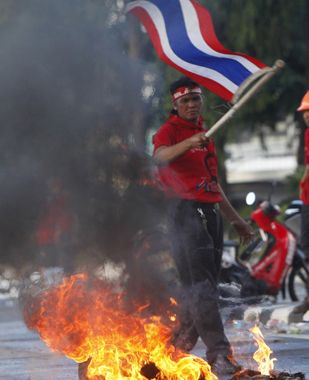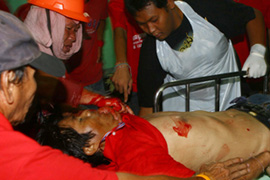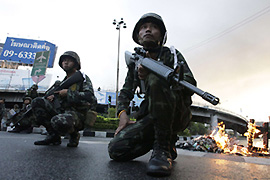Running battles on Bangkok streets
Scores injured as military opens fire in clashes with anti-government protesters.

Protesters also tried to crash buses into lines of soldiers and there were reports that some may have prepared explosive devices using cooking gas canisters.
Earlier, in a televised address, Abhisit said the government was taking all steps to ensure public safety.
But Al Jazeera’s correspondent Tony Cheng, reporting from the Din Daeng area of the Thai capital, said the protesters showed no sign of backing down and were trying to regain ground shortly after being pushed back by advancing troops firing machine guns into the air.
But he said soldiers were firing very close to ground level and the risk of serious injuries or deaths was very high.
State of emergency
In his address, Abhisit said the state of emergency, which he declared on Sunday, was to restore calm and would remain for only as long as necessary.
| In depth |
|
|
He said that troops would only use force in self defence and said that protesters had seized three cooking gas trucks and were threatening to blow them up.
Our correspondent said that while protesters had placed several cooking gas canisters in the middle of the road in an effort to keep troops at bay, he had not seen any gas trucks at the scene.
Peeraphong Saicheau, the director of the Bangkok Medical Centre, said 77 people had been injured, with 19 admitted to hospitals.
Four people had gunshot wounds – two civilians and two soldiers – he said.
An army spokesman said that soldiers, who were trying to clear the intersection, were shot at by protesters before dawn and had fired back.
Colonel Sansern Kaewkamnerd told local radio that troops would “start with soft measures and proceed to harder ones”, but said: “We will avoid loss of life as instructed by the government.”
Military blamed
Sean Boonpracong, the international spokesman for the United Front for Democracy Against Dictatorship, the group that has been leading the Red Shirts’ protests, criticised the military’s “aggressive tactics … shooting at unarmed civilians”.
But he admitted to Al Jazeera that “some of us have to fire back in defence with handguns”.
| In video |
|
|
The spokesman demanded the army halt its operations immediately and repeated the Red Shirts’ key demand that Abhisit resign, dissolve parliament and call fresh elections.
“If things get any worse, there will be more blood and the government will be responsible,” he said, adding that if the army started shooting at protesters, they may occupy Government House for their “safety”.
Panitan Wattanayagorn, a spokesman for the government, said troops had successfully cleared the busy intersection near Bangkok’s Victory Monument landmark where about 100,000 people had gathered late last week to demand Abhisit’s resignation.
“The operation is complete, and a number of protesters have been detained in safe places,” Panitan said on national television, soon after the military crackdown.
“The operation is in line with the law, accountable and reasonable.”
But our correspondent said protesters had returned to the intersection hours afterwards.
‘No martial law’
Panitan told Al Jazeera that Abhisit had “delegated power in terms of operations” to a committee led by several military officers who were “handling the emergency situation”.
 |
| Medics say at least four of the wounded had gunshot injuries [AFP] |
But he said that the prime minister remained in charge of the country and that there was “no martial law”.
He also said that the military had been given live ammunition but were “under strict orders not to aim at the people or not to shoot at the people”.
Keen to show that he still commanded the loyalty of the armed forces and the police, Abhisit was flanked by commanders of the army, navy, air force and the deputy police chief when he made his televised address on Monday.
“I can confirm that the government and security agencies are still unified. You can see all the heads of the armed forces meeting with me right now,” he said.
But the loyalty of the police force has been questioned after some policemen were seen putting on red shirts and joining protest rallies.
Thailand has seen weeks of protests by the Red Shirts, who support Thaksin Shinawatra, the prime minister ousted in a military coup in 2006.
‘Calculated move’
Thaksin, who continues to wield considerable political influence in the country, despite being in exile since September 2006, called on Sunday for his supporters to overthrow the government, promising to return if the government moved to crack down on protests.
 |
| The Thai PM says soldiers have been ordered to open fire only in self-defence [Reuters] |
T Kumar, the Asia and Pacific director at Amnesty International USA, told Al Jazeera that the military’s action against Thaksin supporters on Monday contrasted sharply against its inaction against anti-Thaksin demonstrators who held protests last year against two successive governments filled with Thaksin allies.
“It was a very calculated move to support the current government, which the military did not do when the current prime minister was in the opposition,” he said.
Those protests eventually led to court rulings that deposed the pro-Thaksin governments and ushered in Abhisit’s government.
“The best way to control this situation is to have an election at this moment,” he said.
If Thailand’s Southeast Asian neighbours and the international community did not press the government to hold elections, the country would “go downhill”, he said.


